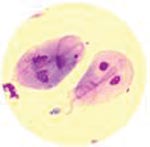GIARDIA FACT SHEET
What is Giardia?
Giardiasis is an infection of the small intestine caused by the protozoan parasite Giardia lamblia. Giardia is one of the most common causes of waterborne disease in humans in the U.S. and Canada, and is the most frequent cause of non-bacterial diarrhea in North America. It is found throughout the world and is one of the most common causes of traveler’s diarrhea. The World Health Organization suspects that 200 million people are infected every year.
What are the Symptoms and the Incubation Time?
The symptoms of giardiasis range from being asymptomatic (having no symptoms) to having severe chronic (long-lasting or frequently-recurring) diarrhea. The incubation period is usually between three to twenty-five days, with an average of about seven. Primary symptoms of giardiasis include: diarrhea, stomach cramps, upset stomach, nausea, vomiting and low-grade fever (fever up to 102°F). These symptoms can lead to weight loss and dehydration.
How Long do the Symptoms Last?
Giardiasis usually lasts for two to six weeks in average healthy humans, but there are also chronic cases that last from a couple of months up to two years in those who are immunocompromised (have a weak immune system).
How is it Diagnosed?
The principal method of diagnosing Giardia lamblia is by observing the organism (taken from a fecal sample) under a microscope. More recently, the detection of Giardia antibodies in the saliva has been shown to have a connection with the presence of the parasite in the feces of infected children and appears to be much more sensitive than fecal examination.
Am I at Severe Risk for Disease?
Giardiasis can infect everyone, although the prevalence is higher in children than adults. On the contrary, chronic symptomatic giardiasis is more common in adults than children. Chronic giardiasis is uncommon, but when it does occur it lasts for years. Individuals that are at high risk for this disease if exposed include: AIDS patients, organ transplant recipients, malnourished children and individuals receiving certain cancer treatments. In extreme cases, giardiasis may be fatal.
How Does Giardia Spread?
Even though someone may be asymptomatic when infected with Giardia they can still act as a host or carrier for the pathogen and are still capable of infecting others within their family of household. Giardia can be very contagious, and everyone is at risk. Giardia may be found in food, water, soil or on surfaces that have been contaminated by the feces of an animal or human that is infected. Ingesting food or water contaminated from sewage probably causes most infections. This is commonly referred to as the fecal-oral route of transmission. Person-to person contact is also responsible for the spreading Giardia, but coming into contact with an infected person’s blood does not.
How Can I Prevent Getting Giardiasis?
Ingesting the pathogen causes all Giardia infections; therefore to avoid getting sick, contact with the organism should be avoided. The best method is prevention. Some suggestions of prevention are: avoiding water and food that might be contaminated, thoroughly washing your hands after using the bathroom and before handling food, and avoiding fecal exposure during sex.
How do I Prevent Spreading it to Others?
Giardiasis is very contagious and to avoid spreading it to others, you should always ensure that you: wash your hands with soap and water after using the bathroom, before cooking and before eating; avoid swimming in recreational water during and up to two weeks after you have been infected; and avoid fecal exposure during sex.
What is the Treatment for Giardiasis?
After about a month, Giardia is usually cleared from healthy individuals without treatment. Anti-parasitic drugs are available and are helpful to those who are immunocompromised. Women and children are especially susceptible to dehydration resulting from the diarrheal symptoms brought about by giardiasis and should drink plenty of fluids throughout the illness to avoid this.
How Prevalent is Giardia in Surface Water/Well Water?
If water treatment techniques are neither adequate nor properly implemented, outbreaks of the illness are likely to occur through the consumption of tainted water, or by the use of tainted water for recreational purposes. Surface waters under the influence of agricultural, farming, or residential activity usually have high pathogen levels, with seasonal variation being observed. Wells are at risk of being contaminated if they: have not been properly installed, have cracks in the casing, are not properly located or are too shallow.
How Can We Protect our Water Supplies?
Filtration techniques that are commonly used in water treatment plants can effectively remove Giardia from the water supply. Water disinfectants, depending on their concentration and contact time, may also play a role by inactivating the parasites present in the water supply. The EPA (Environmental Protection Agency) requires that public water systems filter and disinfect any surface water and groundwater that is directly impacted by surface water. 99.9% of Giardia must be removed.
Is My Water Safe? How Can I tell?
Since Giardia is invisible to the naked eye, even the cleanest looking water may be infected with the pathogen. If ever a boil water order is issued, it is important to pay attention to the health advisory notices and to boil and filter all water before using it.
Did you know that our Operation Water Health programs provides teachers with all of the lesson plans and information they need to teach their students what healthy drinking water is, what unhealthy drinking water is, and the health problems that can be caused by unsafe drinking water? Please help us to keep our Operation Water Health program updated! Please chip in $5 or donate $20 or more and receive an Official Donation Receipt for Income Tax Purposes.



